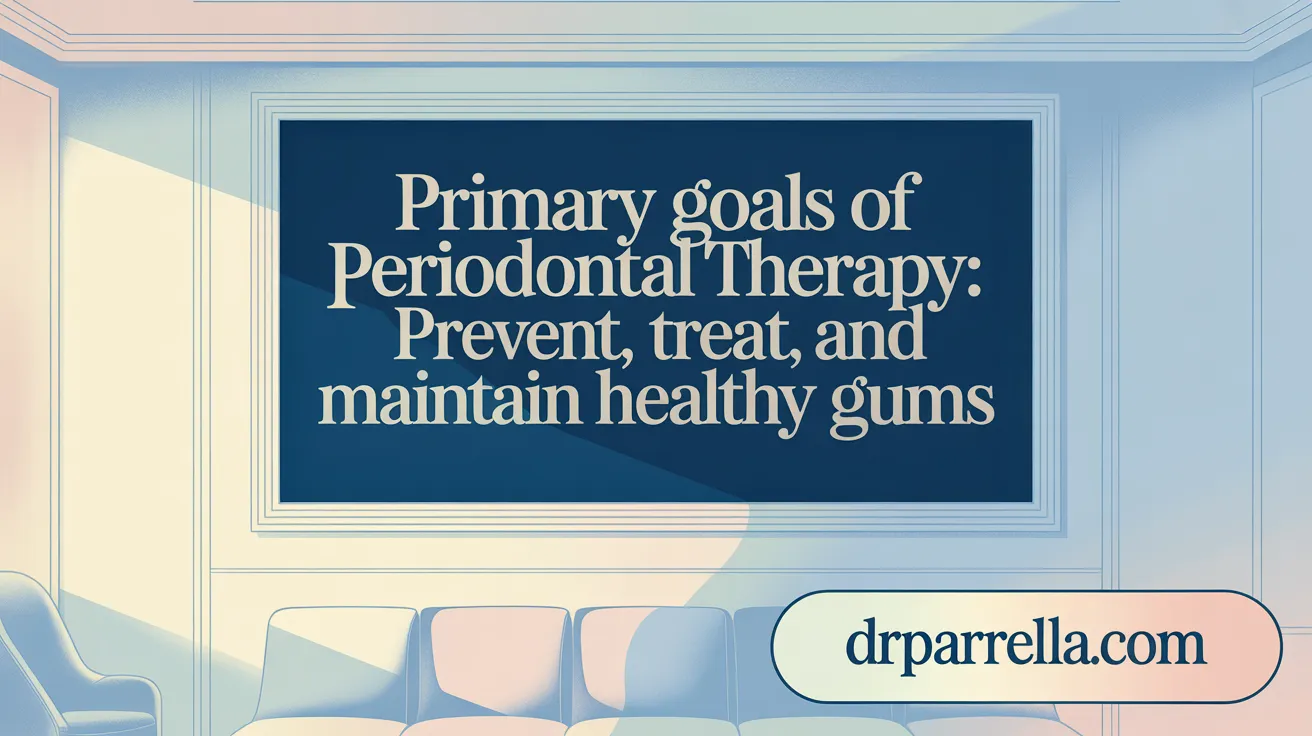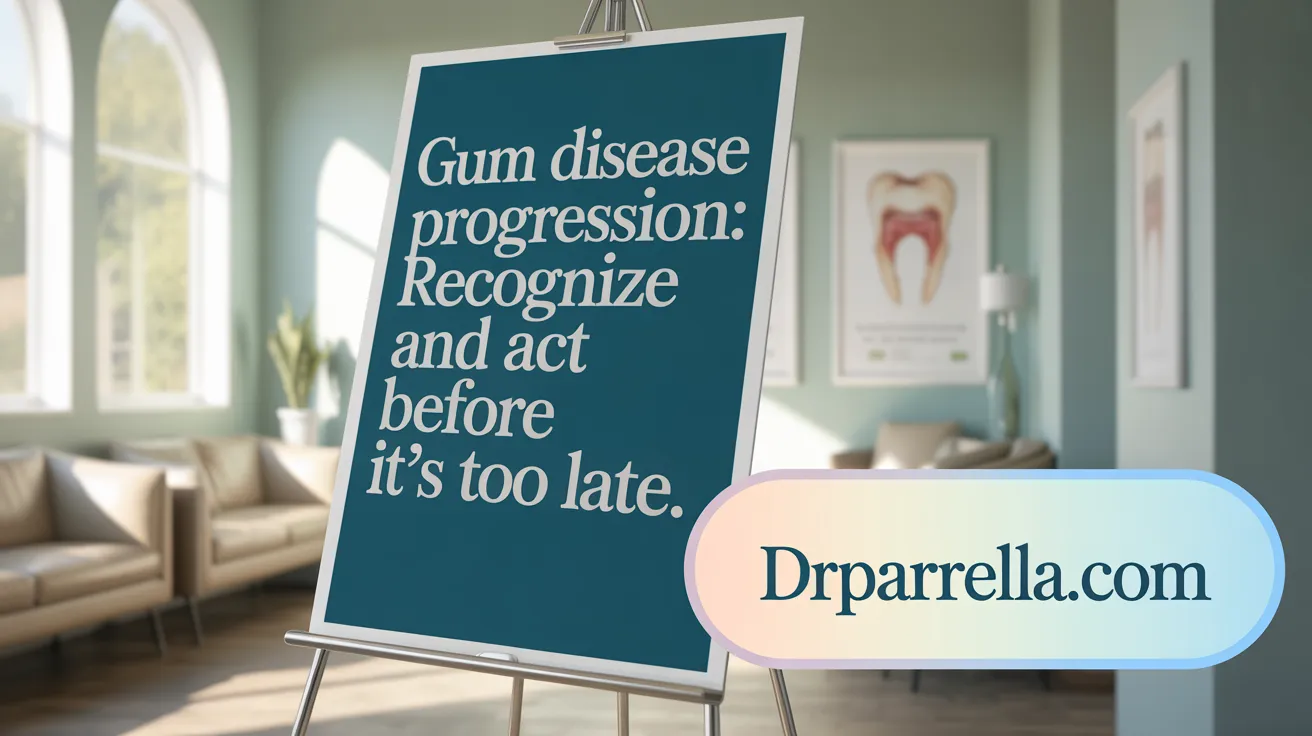What You Need to Know About Periodontal Therapy
Periodontal therapy is a specialized branch of dental care focused on the prevention, diagnosis, and treatment of gum diseases that affect not only your oral health but potentially your overall well-being. With nearly half of adults experiencing some form of gum disease, understanding this therapy is essential to maintaining healthy teeth and preventing complications that can extend beyond the mouth.
Defining Periodontal Therapy and Its Primary Purpose

What is periodontal therapy?
Periodontal therapy is a non-surgical approach to treating and managing periodontal diseases, primarily targeting the gums and supporting structures of the teeth. It includes procedures such as professional cleaning, scaling and root planing, and sometimes the application of medications like antibiotics to reduce bacteria and inflammation.
Purpose and importance of periodontal therapy
The purpose of periodontal therapy is to prevent, treat, and manage gum disease by removing bacterial infection, reducing inflammation, and stabilizing the supporting structures of the teeth. It is vital because untreated periodontal disease can lead to severe outcomes such as tooth loss, bone destruction, and increased risk of systemic health issues like heart disease and diabetes due to the body's inflammatory response (Periodontal Disease and Overall Health).
Goals of treatment
Treatments like scaling, root planing, and medications help halt disease progression, promote tissue healing, and potentially regenerate lost tissue and bone. Maintaining periodontal health not only preserves oral function and aesthetics but also contributes to overall health by decreasing systemic inflammation and related health problems (Systemic Health Benefits of Periodontal Care). Early intervention and consistent maintenance are key, including good oral hygiene practices and regular dental check-ups, to ensure long-term oral and systemic health.
Recognizing the Causes, Symptoms, and Stages of Gum Disease

What are the causes and risk factors of periodontal disease?
Periodontal disease primarily results from the accumulation of plaque, a sticky bacterial film that forms on teeth when oral hygiene practices are inadequate. If not removed regularly through brushing and flossing, plaque hardens into tartar, fueling inflammation and infection of the gums and supporting tissues. Several risk factors for gum disease can increase an individual's susceptibility to gum disease. These include habits like smoking, which can boost risk significantly, and medical conditions such as diabetes and autoimmune disorders that impair immune response. Hormonal changes, certain medications, poor nutrition, stress, and systemic health issues like heart disease also play roles in aggravating the disease process. Additionally, genetic predisposition can make some people more prone. Modifiable lifestyle factors, especially tobacco use and poor dental care, can accelerate progression. Untreated, the disease advances from early reversible inflammation to irreversible tissue and bone loss, leading to tooth loosening and potential loss. Prevention involves maintaining excellent oral hygiene, managing systemic health, and seeking prompt dental care.
What are the symptoms and signs indicating the need for periodontal treatment?
Recognizing early signs of gum disease is vital for timely treatment. Symptoms include gums that appear red, swollen, or bleed easily, especially during brushing or flossing. Persistent bad breath and the presence of pus between teeth and gums are also common indicators. Gum recession which exposes more of the tooth surface and makes teeth look longer, signals advanced inflammation that requires intervention. Sensitivity while eating hot or cold foods, loose teeth, and changes in how teeth fit together or in the bite are additional signs of deeper tissue involvement. Tender and discolored gums, along with visible inflammation or darkening, point toward ongoing infection. Noticing these symptoms should prompt a dental evaluation to prevent further tissue damage and potential tooth loss. Early treatment usually involves professional cleaning and improved oral hygiene to reverse mild cases, but progressive signs demand more comprehensive procedures.
What are the stages of gum disease and how do they relate to treatment?
Gum disease develops through several stages, beginning with gingivitis, the earliest and most reversible form. Gingivitis manifests as inflammation, swelling, and bleeding gums caused by bacterial irritants. If untreated, it can progress to moderate and then severe periodontitis, where infection extends deeper into the supporting structures, leading to gum recession, formation of periodontal pockets, and bone deterioration. As the disease advances, gums detach from teeth, and mobility increases, risking tooth loss. The most severe stage, advanced periodontitis, involves significant destruction of the alveolar bone and tissue, often necessitating surgical procedures like grafts or flap surgery.
Treatment strategies depend on the stage. Early-stage gingivitis responds well to professional cleaning and strict oral hygiene, often reversing the condition entirely. Moderate cases may require scaling and root planing to remove tartar below the gum line. Advanced stages may involve surgical interventions, including grafts and regenerative procedures, to repair or rebuild lost tissue and bone. Early detection is crucial to preserve natural teeth and prevent systemic health complications linked to periodontal disease. Regular dental visits and diligent home care play essential roles in managing each stage effectively.
Comprehensive Periodontal Treatment Options and Procedures

Overview of periodontal treatment options
Periodontal therapy offers a range of treatments designed to manage and reverse gum disease, depending on the disease's progression and severity. The main goal is to eliminate bacterial infection, reduce inflammation, and restore the health of the supporting tissues of the teeth. Treatments are broadly categorized into non-surgical and surgical procedures.
Procedures involved in periodontal therapy
Non-surgical procedures are typically the first line of treatment and include scaling and root planing. This deep cleaning process involves removing plaque and tartar above and below the gum line, smoothing root surfaces to promote reattachment of gums, and often includes the use of antibiotics or antimicrobial mouth rinses to reduce bacterial load. Surgical interventions are indicated for more advanced cases or when non-surgical methods are insufficient. These include flap surgery to access deep pockets, osseous surgery for bone recontouring, and tissue grafts to cover exposed roots or regenerate lost tissue. Advanced regenerative techniques involve guided tissue regeneration and the use of biologic materials like growth factors to stimulate healing and bone growth. Additional procedures like gum grafting and crown lengthening are performed to improve tissue health and aesthetics, while laser treatments such as LANAP provide minimally invasive options for disease management.
Differences between treatment types
Non-surgical methods primarily involve cleaning and antimicrobial therapy to control bacterial infection and inflammation. They are effective in early stages and moderate cases, focusing on preventing disease progression. Surgical treatments are more invasive but necessary in severe cases where tissue and bone destruction has occurred. They aim to eliminate deep periodontal pockets, restore lost supporting tissues, and improve the functional and aesthetic aspects of the gums. Laser therapies offer an alternative to traditional surgery with less discomfort and faster healing times, suitable for specific cases. Overall, selecting the appropriate periodontal treatment depends on individual diagnosis, disease extent, and patient health, often combining multiple approaches to achieve optimal outcomes.
Benefits of Periodontal Therapy and Its Role in Systemic Health
What are the benefits and health advantages of undergoing periodontal therapy?
Periodontal therapy offers a wide range of health benefits by effectively controlling and treating gum disease. It helps prevent the progression of gingivitis and periodontitis, which can lead to tooth loss. Regular treatment reduces inflammation, removes harmful plaque and tartar, and promotes healing of gum tissues, resulting in a healthier, more attractive smile and fresher breath. Beyond oral health, successful periodontal therapy facilitates early detection of other health issues—such as diabetes and cardiovascular problems—potentially leading to timely intervention. Treatments include non-surgical procedures like deep cleaning (scaling and root planing), antibiotics, and surgical options such as bone or gum grafts, which are tailored to the extent of the disease. Overall, maintaining periodontal health preserves dental function and contributes to overall well-being (benefits of periodontal therapy).
How does periodontal therapy aid in maintaining or improving oral and overall health?
Periodontal therapy plays a crucial role in safeguarding both oral and systemic health by controlling infection and reducing inflammation. In the mouth, it preserves the structural integrity of the gums and supporting bones, preventing tooth loss (periodontal disease progression). Systemically, periodontal treatments lower markers of inflammation like C-reactive protein and cytokines (IL-6, TNF-alpha), which are linked to increased risks of heart disease, stroke, and diabetes (Periodontitis and Cardiovascular Risk). By eliminating bacterial plaque and tartar, therapy reduces bacteria that can enter the bloodstream, thereby reducing their contribution to systemic inflammation and related conditions. Moreover, evidence shows that periodontal management improves blood sugar control in diabetics and enhances endothelial function, emphasizing its importance in overall health. Ultimately, periodontal therapy is an essential part of comprehensive healthcare (systemic benefits of periodontal therapy).
How is periodontal health related to systemic health conditions?
The health of the gums significantly influences overall systemic health due to the interconnectedness of oral bacteria and inflammatory responses. Pathogenic bacteria like P. gingivalis and Fusobacterium nucleatum from infected gums can invade the bloodstream, contributing to the formation of arterial plaques and increasing the risk of cardiovascular diseases, including heart attacks and strokes (connections between periodontal disease and overall health). The chronic inflammation from periodontal disease elevates systemic inflammatory markers, which are also involved in conditions such as diabetes, rheumatoid arthritis, and neurodegenerative diseases like Alzheimer’s (Periodontal Disease and Systemic Health). Additionally, maternal gum infections are associated with preterm birth and low birth weight. Managing periodontal health through proper treatment can reduce the burden of systemic inflammation, lowering the risk of these chronic and acute health issues, thus highlighting the importance of oral health as part of overall wellness (periodontal therapy and systemic health).
Prevention, Maintenance, and Clinical Best Practices in Periodontal Care
What prevention and management strategies are effective for periodontal disease?
Effective prevention and management of periodontal disease hinge on diligent oral hygiene for gum disease prevention practices and proactive professional care. Patients should brush thoroughly twice daily with fluoride toothpaste and floss daily to remove plaque from between teeth and along the gum line. Incorporating antiseptic mouth rinses can further reduce bacterial load. Regular dental visits for professional cleanings and periodontal evaluations enable early detection of any periodontal issues before they escalate. Lifestyle modifications such as quitting smoking, controlling systemic conditions like diabetes, managing stress, ensuring good nutrition, and maintaining a healthy weight greatly diminish risk factors. When periodontal disease is present, treatments like scaling and root planing are first-line responses to remove tartar below the gum line. For more advanced cases, surgical options like pocket reduction, bone grafting, and guided tissue regeneration are advisable. Educating patients on recognizing early symptoms and addressing modifiable risk factors enhances ongoing disease management.
What are the clinical indications and best practices for periodontal care?
Clinical indications for initiating periodontal care include bleeding on probing, increased periodontal pocket depths beyond 3mm, clinical attachment loss, and radiographic evidence revealing alveolar bone loss. Best practices in periodontal care involve a comprehensive assessment that includes probing depths, attachment levels, radiographs, and evaluation of systemic health factors. Management strategies should follow current guidelines, utilizing procedures like scaling and root planing, which effectively debride plaque and calculus from above and below the gumline. Adjunctive therapies such as local antimicrobials or systemic antibiotics may be employed based on disease severity. In advanced cases, surgical interventions—such as flap surgery, grafting procedures, or guided tissue regeneration—are indicated to restore lost tissue and bone. Regular re-evaluations are vital to monitor healing and prevent disease progression, with an emphasis on individualized patient care. Incorporating risk factor modifications—such as smoking cessation and controlling systemic health—supports long-term periodontal stability, ensuring preservation of natural teeth and overall oral health.
Maintaining Healthy Gums for a Lifetime
Periodontal therapy is a critical component in managing and preventing the progression of gum disease, which is common yet often overlooked until serious damage occurs. Early recognition of symptoms, combined with timely intervention featuring a tailored mix of non-surgical and surgical treatments, can effectively preserve your natural teeth and protect overall health. Equally important is adopting consistent oral hygiene habits, lifestyle adjustments, and regular professional monitoring to sustain the benefits of therapy and prevent disease recurrence. By understanding the significance of periodontal health and its broader impact, individuals can take proactive steps to ensure a healthier smile and improve long-term well-being.
